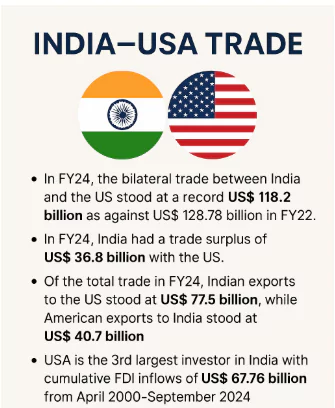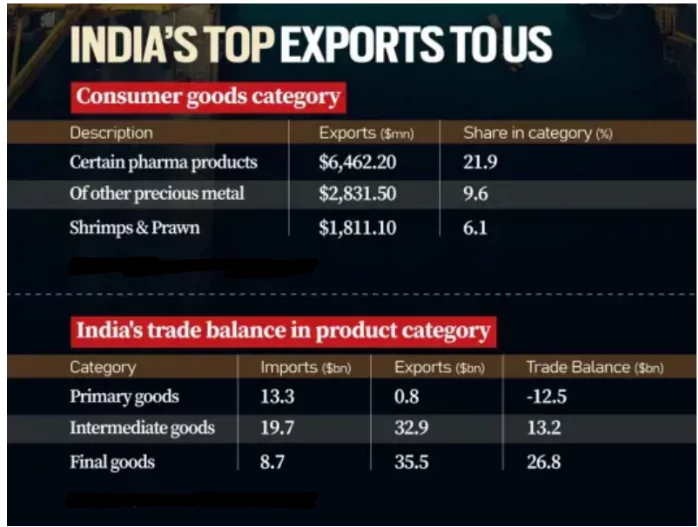US President Donald Trump’s reciprocal tariffs, targeting China (125%) and others (10%) is a potential turning point for India’s economy, similar to the 1991 economic reforms.

Trump Tariffs (TT)
- US President Donald Trump announced reciprocal tariffs (April 2, 2025), targeting China (125%) and others (10%).
- Aim: Counter China’s mercantilist policies (export-led growth, import restrictions, reserve accumulation).
- These tariffs aim to reduce the US trade deficit, which currently stands at $1.2 trillion.
- A base tariff of 10% applies to all countries, while country-specific tariffs are imposed from April 9.
- The US has announced the suspension of additional tariffs on India for 90 days until July 9, 2025.
China’s mercantilism:
- Mercantilism, an economic system prevalent from the 16th to 18th centuries, aimed to increase national wealth and power through a combination of government regulation and protectionist trade policies, emphasizing exports over imports.
- Export-led growth model: China maintained a consumption-to-GDP ratio of just 35% in 2010, prioritizing exports over domestic demand.
- World’s largest exporter: China’s share of global manufactured goods exports rose from 4% in 1996 to 30% today, reflecting its aggressive export strategy.
- Persistent trade surplus: China has sustained massive trade surpluses for decades, stockpiling foreign reserves — a classic mercantilist move.
- Limited market access for imports: China imposes non-tariff barriers and subsidies to restrict imports while promoting domestic champions.
- Strategic currency policy: The managed undervaluation of the yuan for years boosted export competitiveness and discouraged imports.
|
Geopolitical Reactions to US Tariffs
- China’s resolute opposition: China will impose 125 per cent tariffs on US goods.
- This comes after the US decided to pause tariffs for 90 days on many countries, but hit China with a 145 percent tariff amid the ongoing trade wars.
- Japan opts for negotiated settlement: Japan chose a diplomatic route, sending a team to negotiate with the US.
- Its goal was to protect economic interests through peaceful dialogue.
- EU considering both options: The EU adopted a balanced approach—open to negotiations while preparing retaliatory measures.
- It emphasized the importance of safeguarding its €1.5 trillion trans-Atlantic trade relationship.
India’s Stance on US Tariffs

- Strategic Restraint: India did not retaliate against US tariffs; instead, it opted for dialogue and negotiation.
- Bilateral Trade Agreement (BTA): Actively negotiating a BTA with the US to expand trade from $191 billion to $500 billion by 2030.
- Government Response: Commerce Minister urged exporters to stay calm and emphasized India’s image as a trusted and stable trade partner.
- Tariff Pause Advantage: US paused 26% reciprocal tariffs on India for 90 days (till July 9, 2025), recognizing India’s cooperative approach.
- Opportunity Focus: India views the situation as a chance to boost manufacturing, attract investment, and integrate into global supply chains.
Impact on Indian Economy
- Stock Market Volatility: Sensex plunged over 2,000 points on April 7, 2025, after tariff announcement.
- Indian markets fell less than others but reflected global trade tension sensitivity.
- Export Sector Disruption: India faces a 26% reciprocal tariff; sectors like auto (3% of exports) and IT are hit.
- Nifty IT fell by over 3% due to fears of reduced discretionary spending in the US.
- Though temporarily exempted, India’s $12.2B pharma exports to the US are vulnerable to future tariff hikes.
- Reduced Export Competitiveness: Higher tariffs increase product prices abroad, making Indian exports less competitive, especially in metals, electronics, and chemicals.
- Pressure on Monetary Policy: RBI cut repo rate by 25 bps to 6% on April 9, citing global uncertainty and impact on exports.
- Risk of Inflation: Tariff-induced global inflation could spill into India via imported goods, affecting household budgets and input costs.
- Uncertainty in FDI & Investor Sentiment: Unstable global environment may deter new investments.
- India already saw FDI dip to <1% of GDP by 2025.
1991 LPG Reforms (Liberalization, Privatization, Globalization)
- LPG reforms, announced on July 24, 1991, marked a shift from a heavily regulated, socialist-inspired economy to a more market-oriented one.
- The primary goals of the LPG reforms were to address the economic crisis, increase economic growth, and build foreign exchange reserves.
- Liberalization: This involved reducing government control and regulations in various sectors, including industry, trade, and finance.
- This meant lowering tariffs, relaxing import restrictions, and allowing greater freedom for businesses.
- Privatization: Ownership of government-owned enterprises transferred to the private sector.
- This was done through disinvestment and the encouragement of private sector participation in various industries.
- Globalization: This involved opening up the Indian economy to international trade and investment.
- This included reducing trade barriers, attracting foreign direct investment, and integrating the Indian economy with the global market.
|
Opportunities for Indian Economy
- Second 1991 Moment – Trigger for Reforms: External pressure provides the political cover needed to push trade, FDI, and industrial reforms.
- Boost to Manufacturing & PLI Schemes: US-China decoupling accelerates “China+1” strategy, India can attract global firms in electronics, pharma, and EVs.
- Apple aims to shift 25% iPhone production to India by 2025.
- PLI schemes target $520 bn manufacturing output by 2026.
- Repositioning as Global Supply Chain Hub: China’s 125% US tariff creates space for India in manufacturing.
- India is seen as a “trusted and reliable partner” in global trade.
- Boost to Bilateral Trade Talks with US: India–US BTA in progress, aiming to grow trade from $191B to $500B by 2030.
- India’s non-retaliatory diplomacy helped pause the 26% tariff for 90 days.
- Greater Leverage in FTA Negotiations: Simultaneous FTA discussions with EU, UK, and CPTPP being explored.
- India is now negotiating from a position of strategic necessity and opportunity.
| The “China+1” strategy is a business approach where companies diversify their manufacturing and supply chain operations beyond China, rather than relying solely on it. |
- Demographic & Workforce Edge: India’s prime-age (25-54), AI-ready workforce set to surpass China’s in coming years — making India more attractive to industries relocating from China.
- Textiles & MSME Export Boost: Indian textiles ($9.6B to US) may gain edge over China (21%) and Vietnam (19%) under new tariff regime.
- Rupee Trade Settlement Expansion: Rising dollar volatility and US-centric risk offers India a chance to expand rupee trade with Russia, Iran, UAE, Africa.
- Reduces dollar dependency & improves sovereign economic autonomy.
- Tech, Innovation & Startup Ecosystem Gains: India can attract venture capitalists (VC) and tech giants diversifying away from China.
- Startup India, DPI (Digital Public Infrastructure), Open Network for Digital Commerce (ONDC), UPI have already created global interest.
- Agricultural Market Access: Bilateral Trade Agreement (BTA) may open up US agri markets for Indian rice, spices, and organic produce.
- Push for farm sector R&D and tech-backed productivity growth.
Way Forward & Reforms Needed for India
- Trade Policy Modernization: India’s trade-weighted import duties (12%) are among the highest globally (vs. 2.2% US, 3% China).
- High tariffs make Indian goods less competitive, inflate costs for domestic industries, and hinder integration into global value chains.
- Pursue “zero-for-zero” industrial goods agreements, starting with the India-US BTA as a template for upcoming EU/UK deals and eventual CPTPP accession.
- Reform and Liberalise FDI and BITs: FDI inflows have fallen below 1% of GDP, from 2–2.5% over two decades.
- The 2015 “model” bilateral investment treaty (BIT) mandates Indian courts for dispute resolution — a major deterrent for foreign investors.
- Revamp BITs to include neutral arbitration mechanisms and attract long-term capital investment.
- Deepen Trade Integration via Strategic FTAs: India’s global export share remains low (1.8% in 2023), far below China (15.4%).
- Expedite trade agreements with the US, UK, EU, and consider joining the Comprehensive and Progressive Agreement for Trans-Pacific Partnership (CPTPP).
- Reform Land, Labour, and Agriculture Laws: Outdated laws constrain ease of doing business and industrial competitiveness.
- Rollback of 2020–21 farm laws under political pressure stalled essential agricultural reform.
- Reintroduce these reforms with better consensus-building and implementation strategies.
- Boost Export-Oriented Manufacturing: Job creation in India depends on scaling manufacturing exports, especially in labour-intensive sectors like textiles and toys.
- Make in India struggled due to protectionism and neglect of such sectors.
- India holds just 6% of the US textile market, vs. Vietnam (19%) and China (21%). TT could shift supply chains — India must seize this opportunity.
- Invest in R&D and AI-Ready Workforce: India’s demographic dividend is peaking; its prime-age labour force will soon exceed China’s.
- Invest in skilling, R&D, and digital infrastructure to ride the AI and innovation wave.
- The West is increasingly looking at India as a counterweight to China; building a skilled, export-capable workforce is critical now.
- Diversify International Trade Partnerships: Resume and conclude negotiations for the long-pending India-EU Free Trade Agreement by 2026 to access Europe’s $18 trillion market, particularly for pharmaceuticals, IT services, and automotive exports.
- Proactively lead developing nations in WTO reforms while expanding rupee trade settlements to 50+ countries, building on the successful Russia-UAE payment mechanisms that bypass dollar dependence.
Conclusion
India must leverage US-China trade tensions to push long-pending reforms. Strategic alignment with the West can accelerate growth to 8%+. Second 1991 moment hinges on bold economic policy shifts.
![]() 12 Apr 2025
12 Apr 2025



